STORIES FROM THE PLATTELAND
Steytlerville – the Karoo village where everybody knows your name
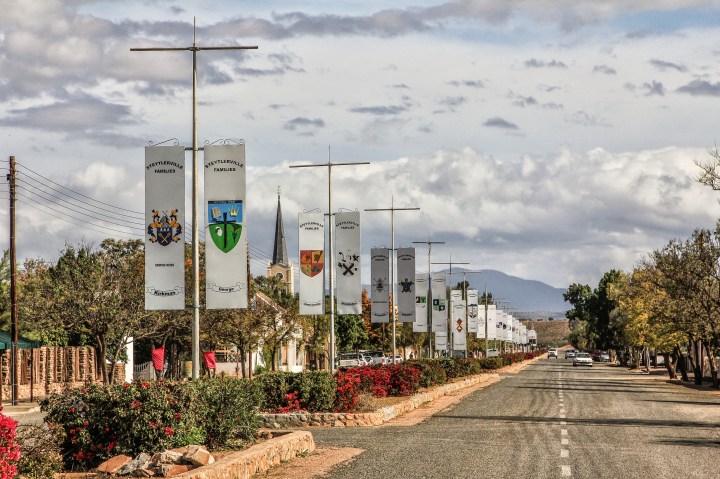
There’s a village in the Eastern Cape Karoo where local families are celebrated and remembered like nowhere else in the world.
When next you’re down in Steytlerville, just take an early-morning stroll along the main road of this glorious little Karoo village tucked into a valley near the Baviaanskloof.
Look up at the family crests suspended along the middle of this street with its crimson bougainvillea shrubs.
Now conjure up some Wi-Fi, head on off to Google and hunt for any other settlement on Earth that displays its residents’ family crests like this. No luck? We didn’t have any either.
Can you imagine how some of those families involved must feel, knowing that even though their ancestors might not have fought in the Crusades, won a bloody battle on a Scottish moor or even been knighted for brave deeds, they are remembered in their own, possibly more locally important, ways?
Among the plumed helmets, lions rampant, swords, shields and Latin mottoes of the European-origin crests is a collection of very unusual homespun familial badges as well.
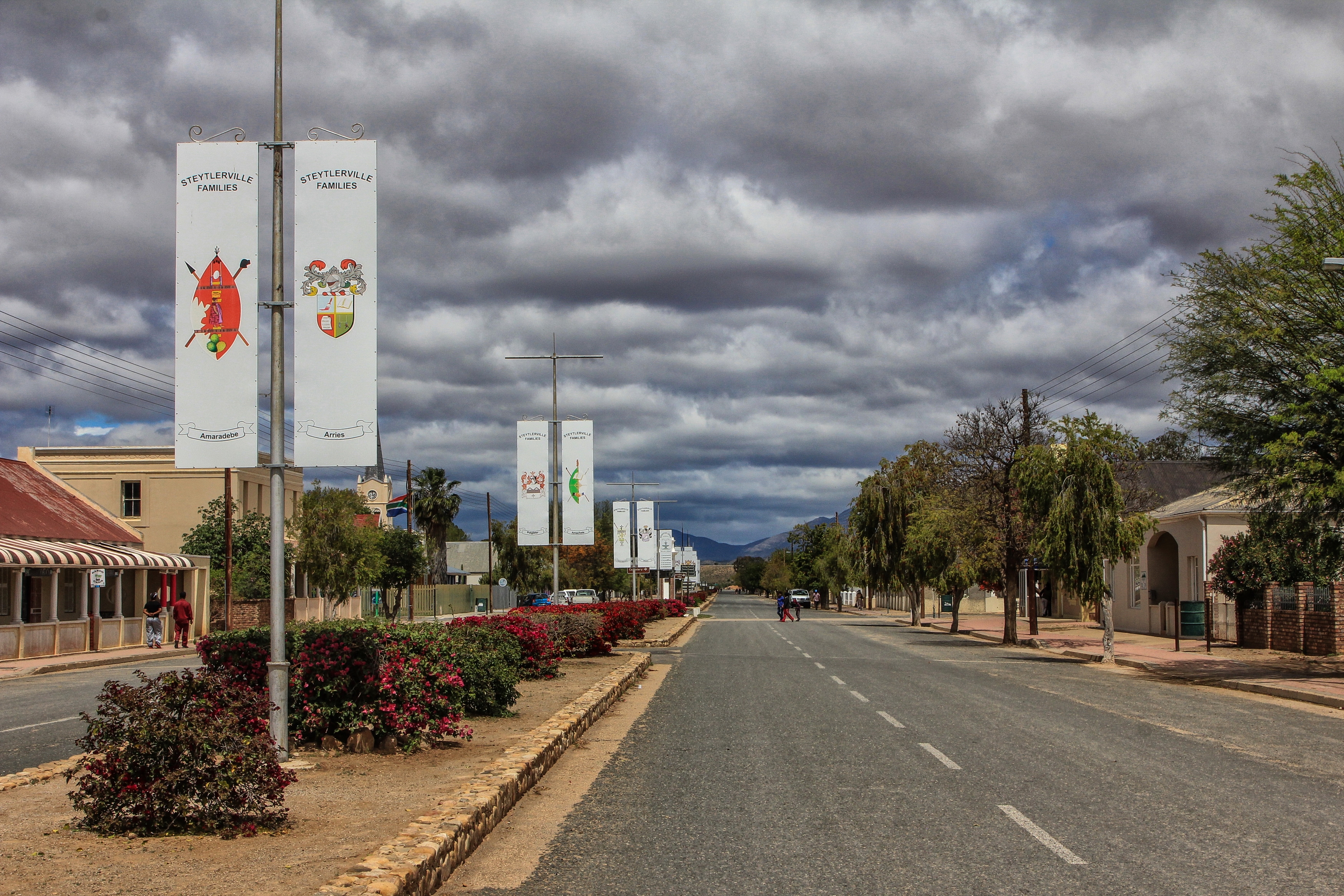
The all-inclusive family crest array in Steytlerville. Image: Chris Marais
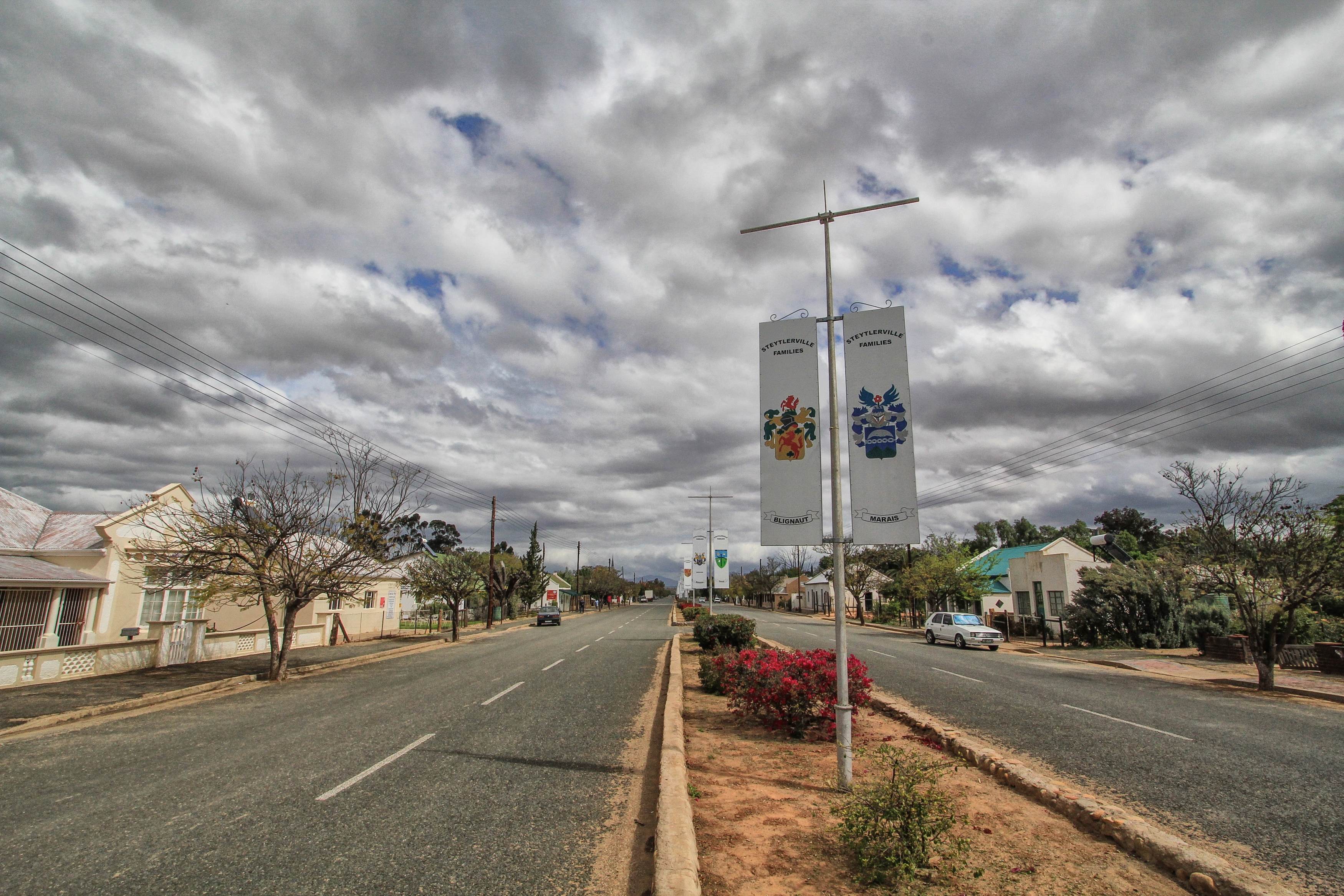
One of the widest main streets in South Africa is to be found in Steytlerville. Image: Chris Marais
Local royalty
Here’s a laughing Angora goat, there’s a Xhosa spear, here’s a donkey and there’s a rugby ball. Not to mention shearing blades, many depictions of Aloe ferox, war axes, a favourite milk cow, cooking pots, the distant iconic outline of the Cockscomb mountain, kudu horns and the classic Karoo windpomp.
A number of the Karoo-style crests depict white, black and brown-hued hands clasped in friendship. Or are they arm-wrestling? We’ll go for the friendship option. This quite astounding bit of platteland community-building also has the great spin-off of being one of the most authentic tourist attractions ever devised for a small town anywhere.
The US and Australia specialise in eccentric rural attractions, mainly devised to get motorists off the highways and into the local diner. Here one thinks of The Big Crayfish, the Giant Ned Kelly, the Cadillac Ranch, the Big Moose, the Giant Milk Bottle, the Very Big Pistachio, the Big Donut, the OK Corral, The Monster Wombat, not to mention the Very Large Ball of Twine.
Here in South Africa, we have the Big Pineapple of Bathurst and the Big Postbox of Calvinia. And one wonders how Mother Hubbard’s shoe-up in Limpopo is going these days? But there’s nothing like the family crests of Steytlerville.
Valley of the Flags
Some years ago, we headed down to this magical place, with its wide streets and remarkable sunsets, to find out more. Our trail first led a short distance out of town, to The Valley of the Flags, Noorspoort Guest Farm and owner George Craven.
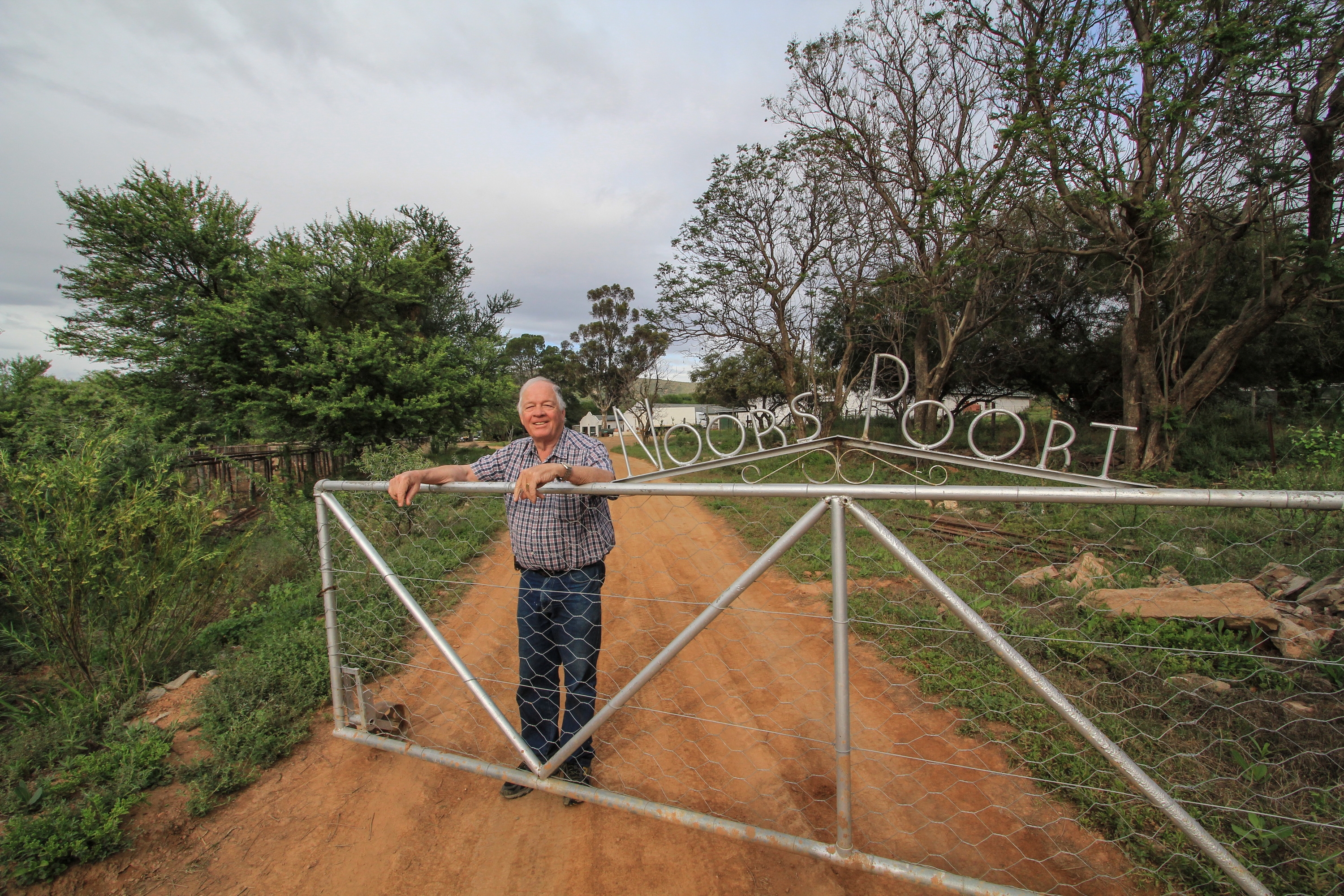
George Craven – passionate about promoting the South African platteland. Image: Chris Marais
George, son of rugby legend Danie Craven, will probably go down in history as the man who worked hardest to bring people back to the platteland in the mid-Eighties. He was 10 years before his time. The Steytlerville Crests project, as New South Africa High Road as they come, has a link to an Old South Africa initiative, which was drenched in outrage, drama, protests and a spot of comedy.
“In the late apartheid era, central government sent out word to the municipalities that they were to try to popularise the national flag,” said George.
“I was a counsellor at the time and suggested the flag be painted on some roadside rocks outside town. They said, oh what a good idea, won’t you do it for us? I was quite agile back then, so I hung on a rope for three days and painted it.”
A new South African solution
But when the New South Africa rolled into view, the flag on the rocks became a very contentious issue. One of Cravens’ sons, Le Roux, suggested adding the new flag next to the old one.
“So Le Roux went up there for three days and painted in the modern SA flag, even bigger than the old one.
“Meanwhile the town was split over this issue. There were pro- and anti-flag people. The ratepayers and the farmers’ associations had meetings about this. Finally the ANC supporters marched off to deface the old one but there was the issue of people forgetting to bring water, and no ladder, and the guy who went up to deface the old flag fell down after climbing up. So it had a long paint stripe through it, made as he fell.
“A few weeks later someone threw a bag of paint at the new flag, so that was also defaced.”
George called up (now late) ANC activist and stalwart Raymond Mhlaba for guidance through these tricky and turbulent waters.
“He suggested the inclusion of other flags on the roadside that depict more of SA’s history.”
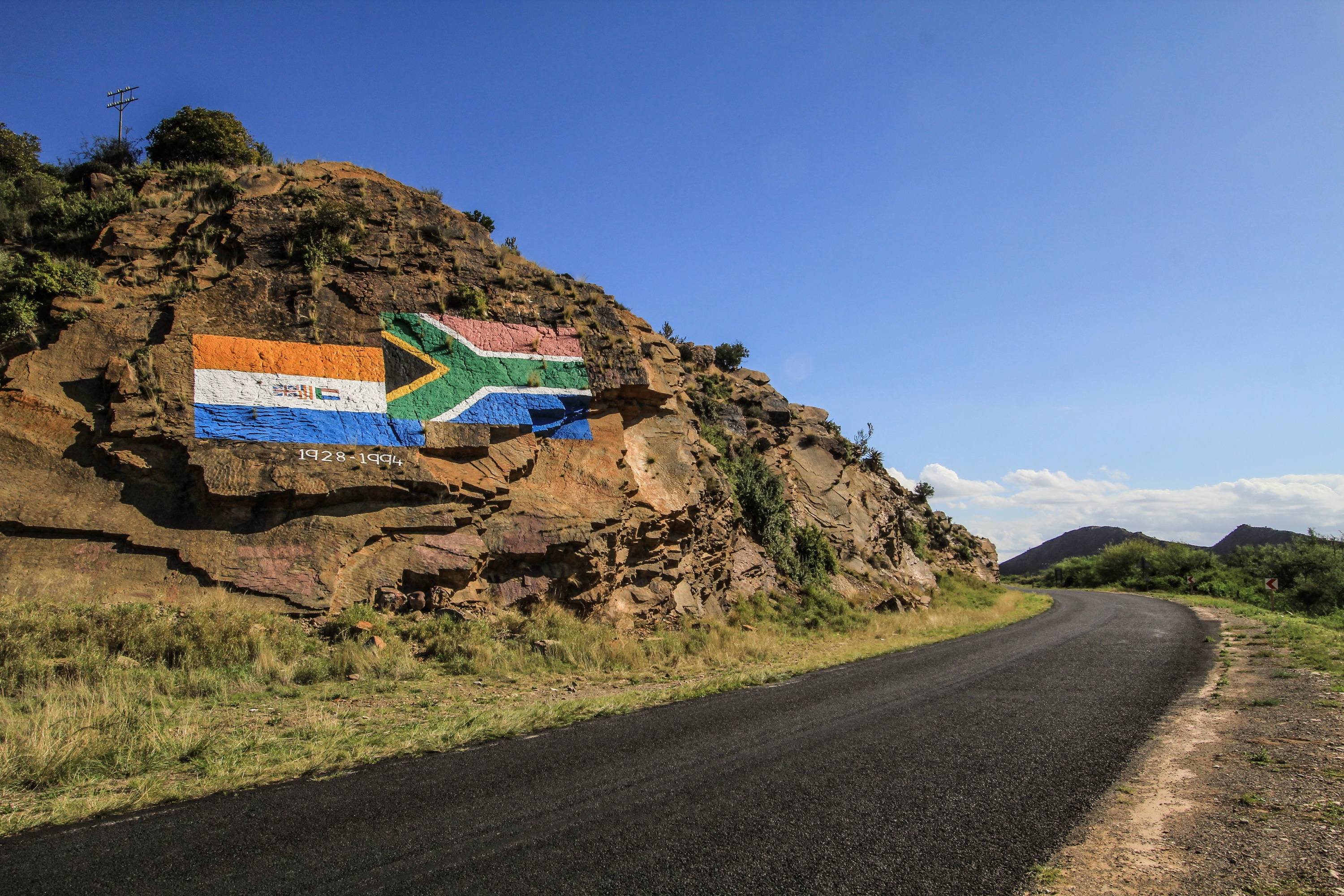
The old and the new, side by side, as part of Steytlerville’s Valley of the Flags. Image: Chris Marais
The crest concept
Local journalist, magazine editor, mohair farmer, estate agent, historian and master chef of choice deli dishes (yes, in the country one wears many hats) Linda Henderson gave a hand, some academic advice was added and the Valley of the Flags was now an acceptable reality.
And it was just after this rocky start that Linda had the idea of hoisting the local family crests up in the village.
“All credit to Linda,” said George. “It was a real Rainbow Nation concept.”
We love to photograph those main street crests, from top to bottom and back again, in morning and evening and midday light conditions. And even though some of them are fading in the harsh Karoo conditions and are urgently in need of a paint job, they’ve got us hooked.
We arranged to meet with Linda Henderson and some of the families honoured on the crests at her home right on the main street.
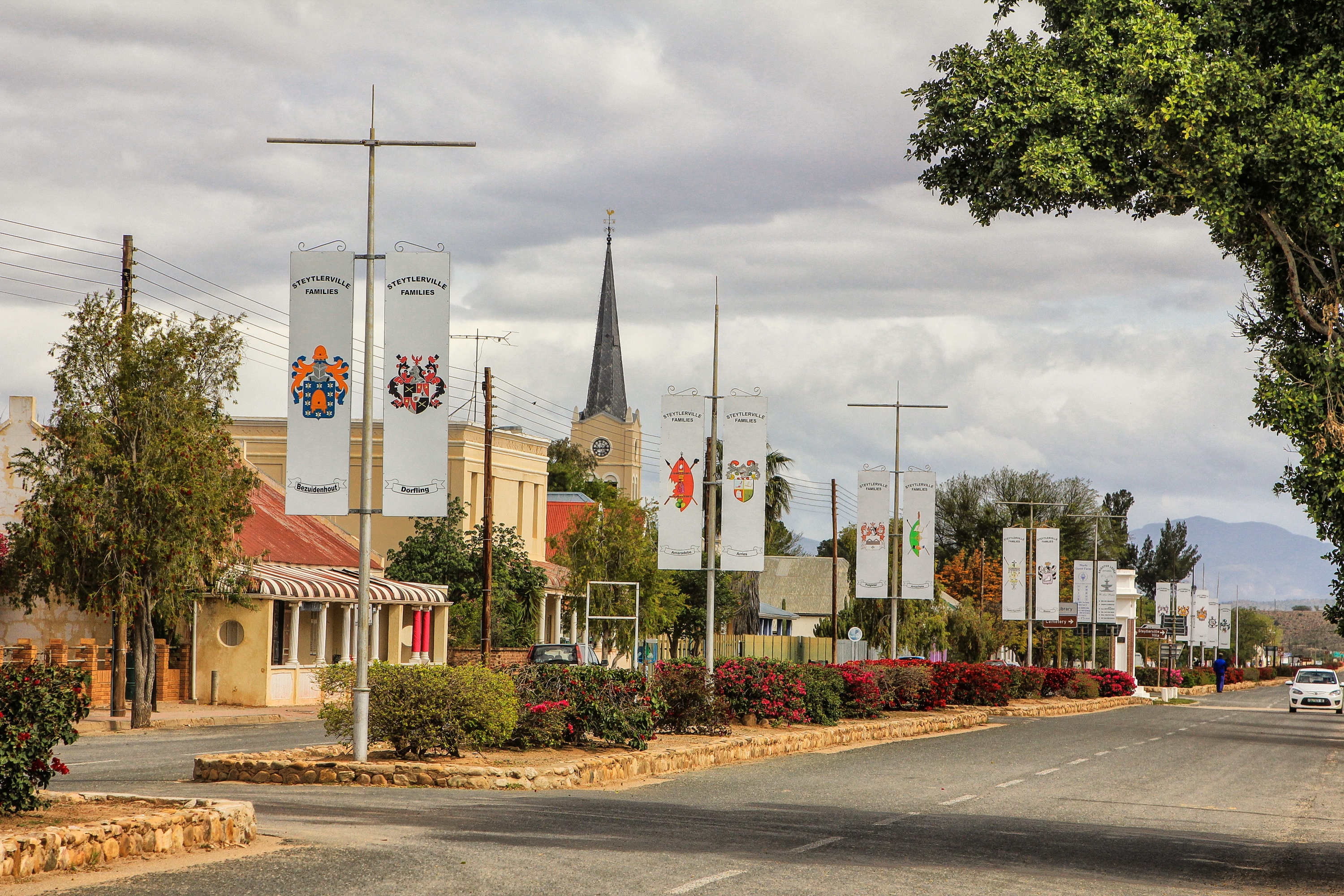
The magic of a good idea – thanks to Linda Henderson and the local tourism office of Steytlerville. Image: Chris Marais
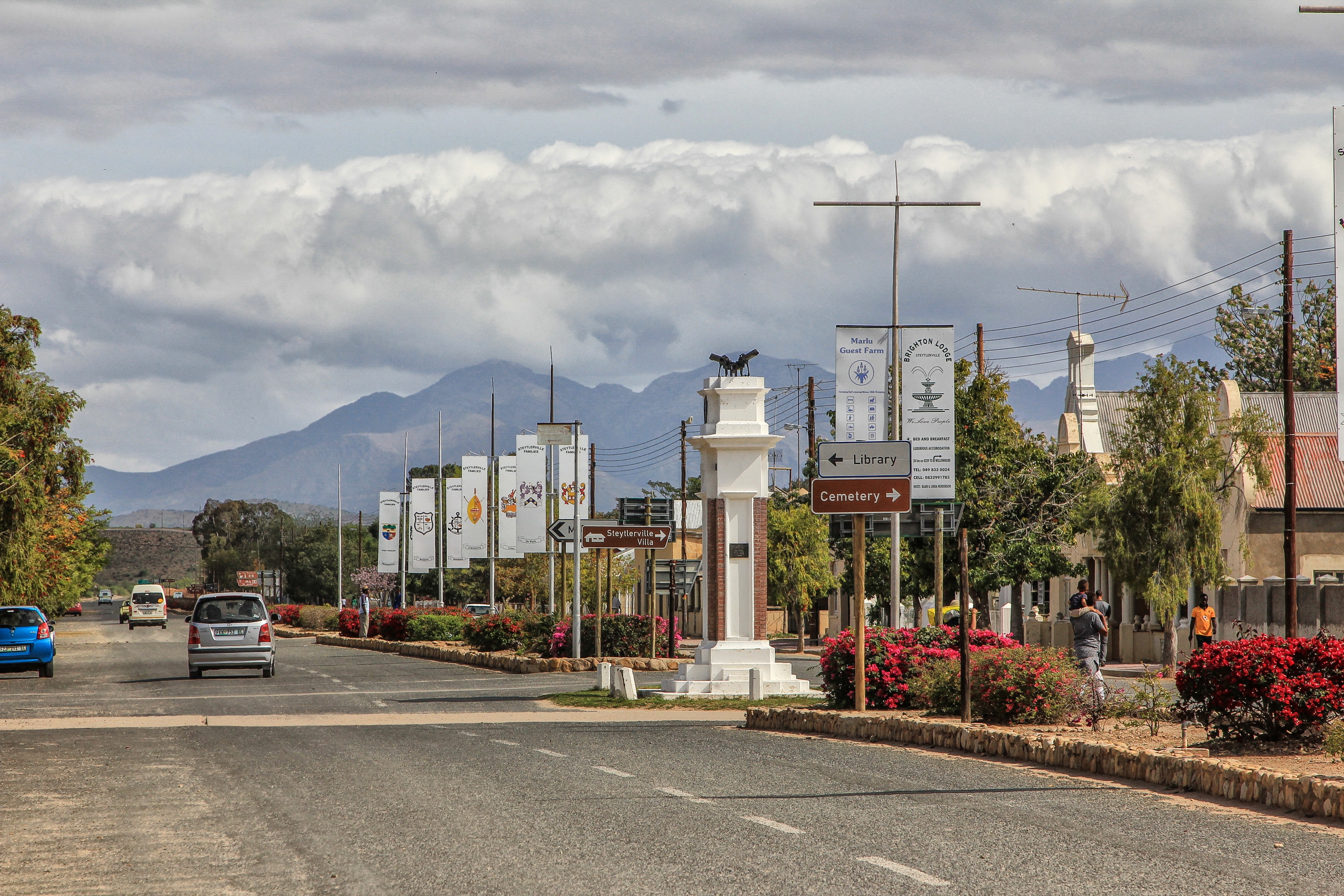
Family crests flanking the War Memorial in Steytlerville. Image: Chris Marais
People make a town
“The crests went up in 2003,” said Linda. “As a newly formed tourism group, we wanted some kind of promotion initiative for Steytlerville. What was special about the place? We didn’t have attractions like the Cango Caves, but we do have incredible people – that’s what makes a town, after all. And it tied up well with the Valley of the Flags outside town. Money for the project was raised from public and private sources.”
So the group began to gather heraldic information on the locals. For some families (like, ahem, the Marais and Du Toit mobs) it was easy – they had the old clan crests to refer to. But for many others, this was entirely new ground.
They called in some academics from the Albany Museum in Grahamstown (now Makhanda) to help.
“So we collected family histories,” said Linda. “And it was such a joy. People would tell us what their forefathers had done, and what was important to them. They also suggested ways that these could be illustrated. So you’ll find cotton reels, baking tins, shearing shears, soccer balls, rugby posts.
“I really hope that people notice the lovely innocence, naivety and humour in some of the crests, the non-heraldic symbolism of Angora goats and cooking pots and hands clasped in greeting – they tell the story of a community.
“One guy’s father had been a shopkeeper for a long time. I asked how they thought we could illustrate that. They said it was easy. Just add a shopping trolley.”
The Kirkman-Middletons
First of the “cresters” to arrive were the Kirkmans, James and Helen (nee Middleton), mohair farmers in the district. James is of 1820 Settler stock, while Helen is the granddaughter of Oubaas Middleton, who started a well-known general dealer in Steytlerville in 1894, selling rifles, gunpowder, mohair and skins.
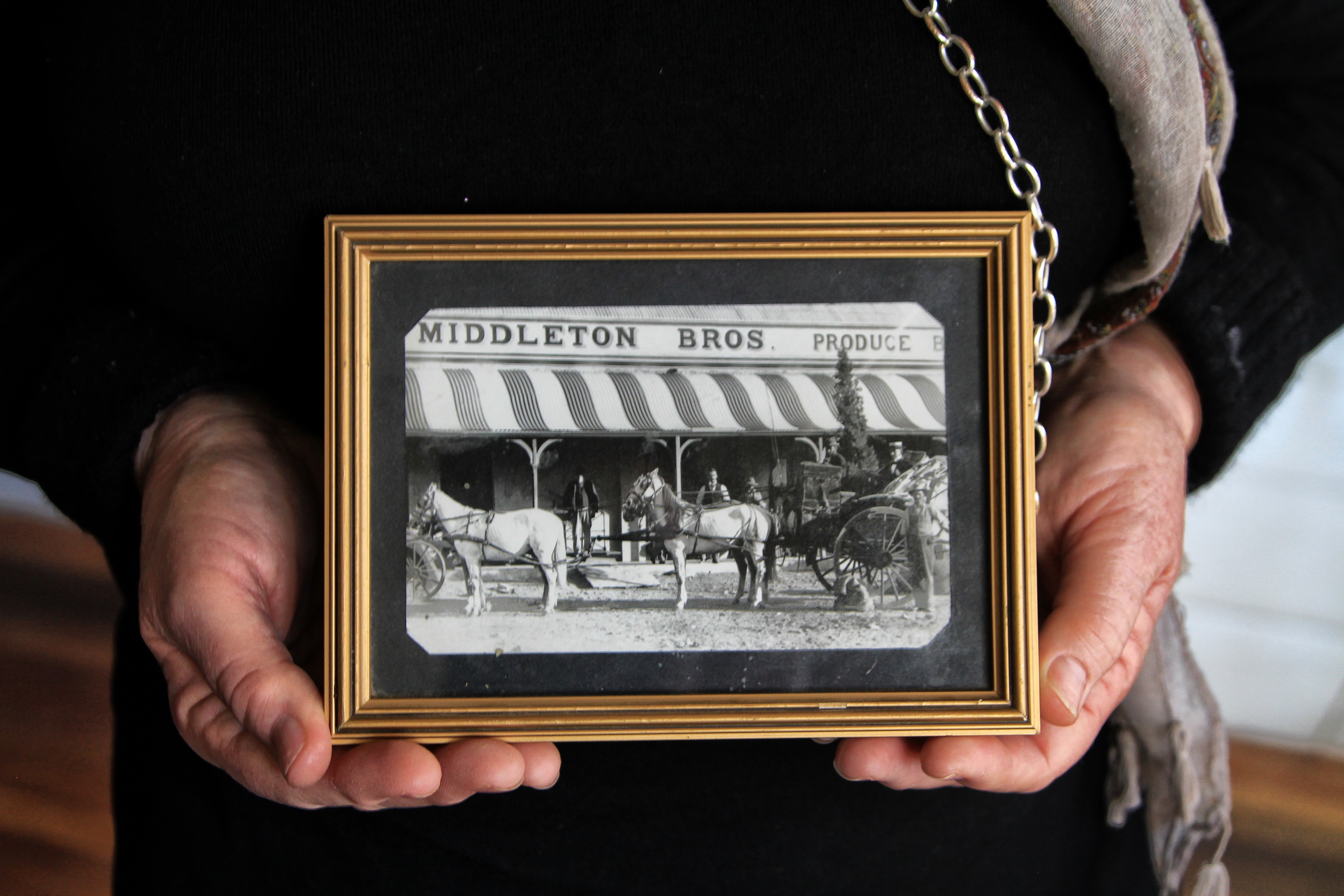
Helen Kirkman’s maiden name was Middleton – one of her ancestors ran this general dealer shop in Steytlerville. Image: Chris Marais
Like many white Eastern Cape families, the Kirkmans are a tweetalige lot, possibly even drietalig at times, mixing in some isiXhosa with their English and Afrikaans.
“Most Afrikaans-speakers around here call me Kerkman,” said James.
Next was Danie Bezuidenhout, who brought along a family memoir and told me, almost as an aside as I took his photograph in the street:
“I’m a descendant of the Slagtersnek Bezuidenhouts.”
The Bezuidenhouts
Now that’s a very long and occasionally dark story to tell, and this is not the place for it. Suffice it to say, those particular Bezuidenhouts were around these parts for decades before the Brits arrived and, later, Danie’s ancestor Roelof Petrus was involved in a short rebellion that, many say, was the spark for the Great Trek of 1838.
The most colourful Bezuidenhout by far was his grandfather Oupa Skietkraal, who had very humble beginnings and ended up owning two racing thoroughbreds called “In the War” and “To the War” and employed the services of a batman called Meerkat.
Thanks to the crests, the Bezuidenhouts have held two family reunions in Steytlerville since 2004.
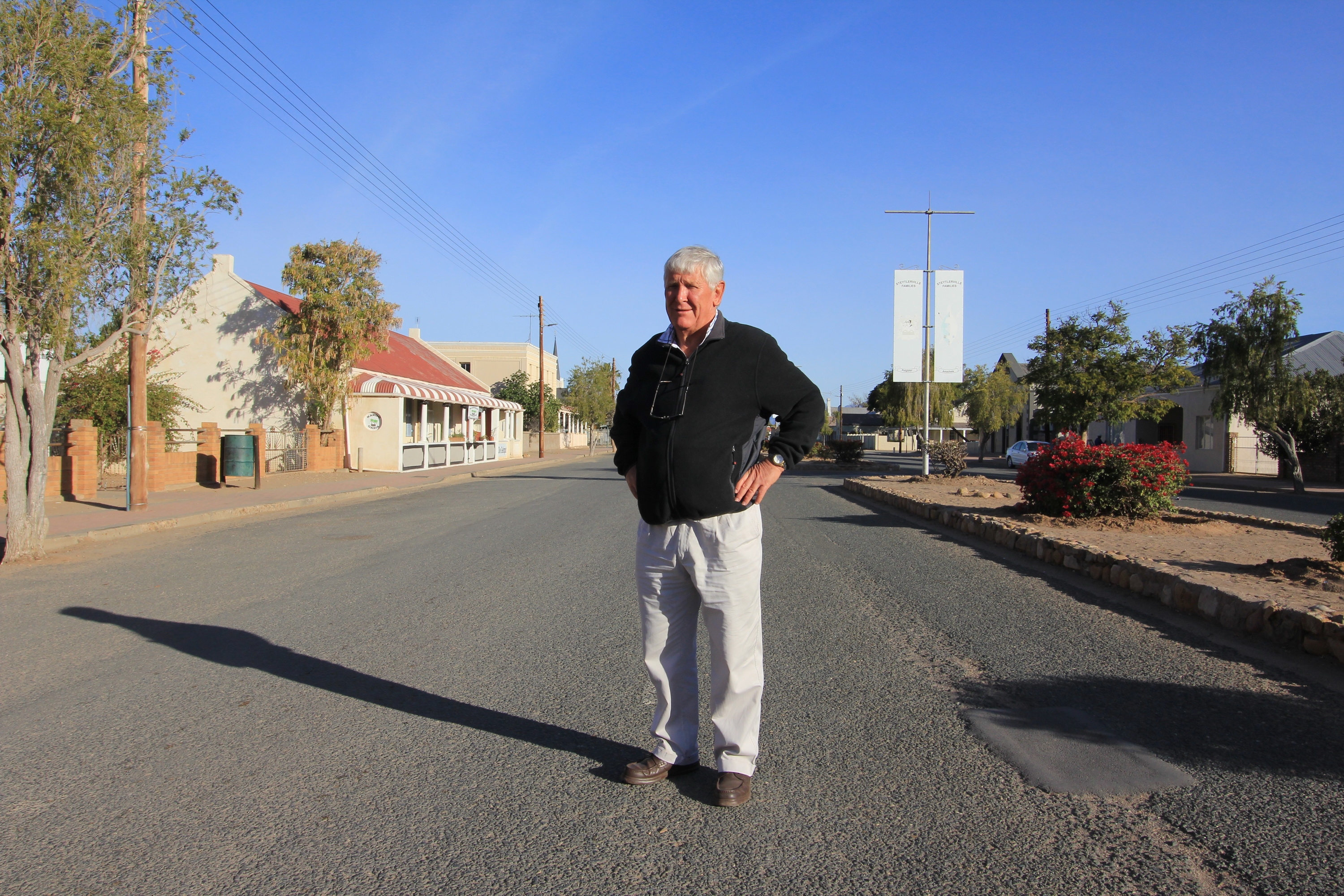
Danie Bezuidenhout’s roots in the Karoo Heartland are multi-generational. Image: Chris Marais
The Matabatas
The Matabatas arrived all the way from Uitenhage, represented by brothers Abraham and Solly.
Originally of Xhosa origin, their home language is now Afrikaans. Ever since the Matabatas were asked to make up their crest (featuring an anchor, a ladder, a Bible, a rugby ball, and a sheep), interest in their own family tree has been awakened. They too have traced and written down their family history starting with farmworkers Oupa Johnny and Ouma Johanna Matabata. The detail they have recorded is astounding.
For instance, all the family nicknames are recorded, and they include: Piet Bulsak, Piet Gifkop, Hendrik Seekat, Jan Pensie, Adam Lekkerlag, Koot Ratelpens, Piet Muishond and Jan Baadjie, to name but a few.
“And we are all very proud of our crest here in Steytlerville,” said the siblings. “We held a family reunion in April 2017, with nearly 300 family members, and it was wonderful showing everyone our crest in the main street.”
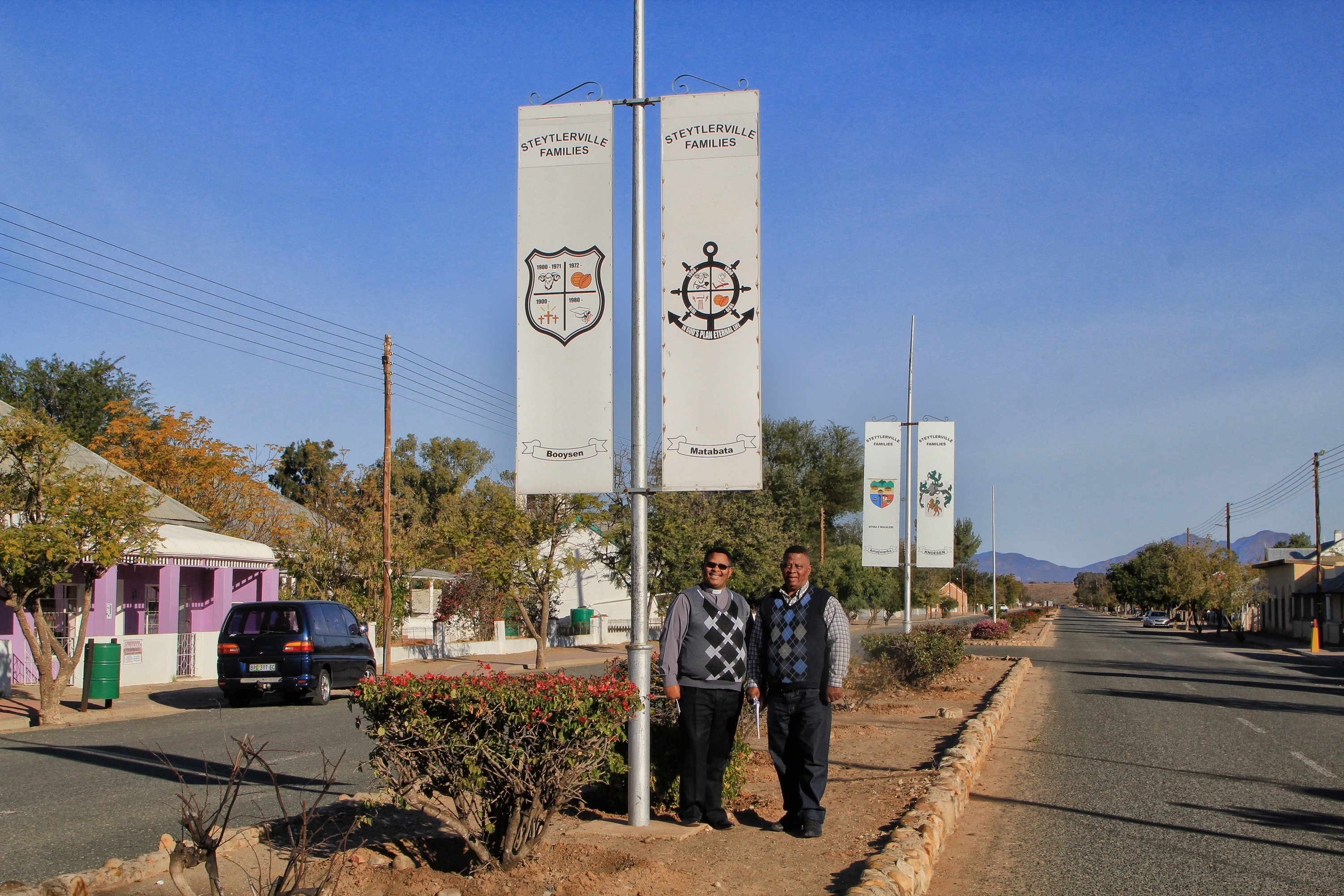
Abraham and Solly Matabata designed their own family crests. Image: Chris Marais
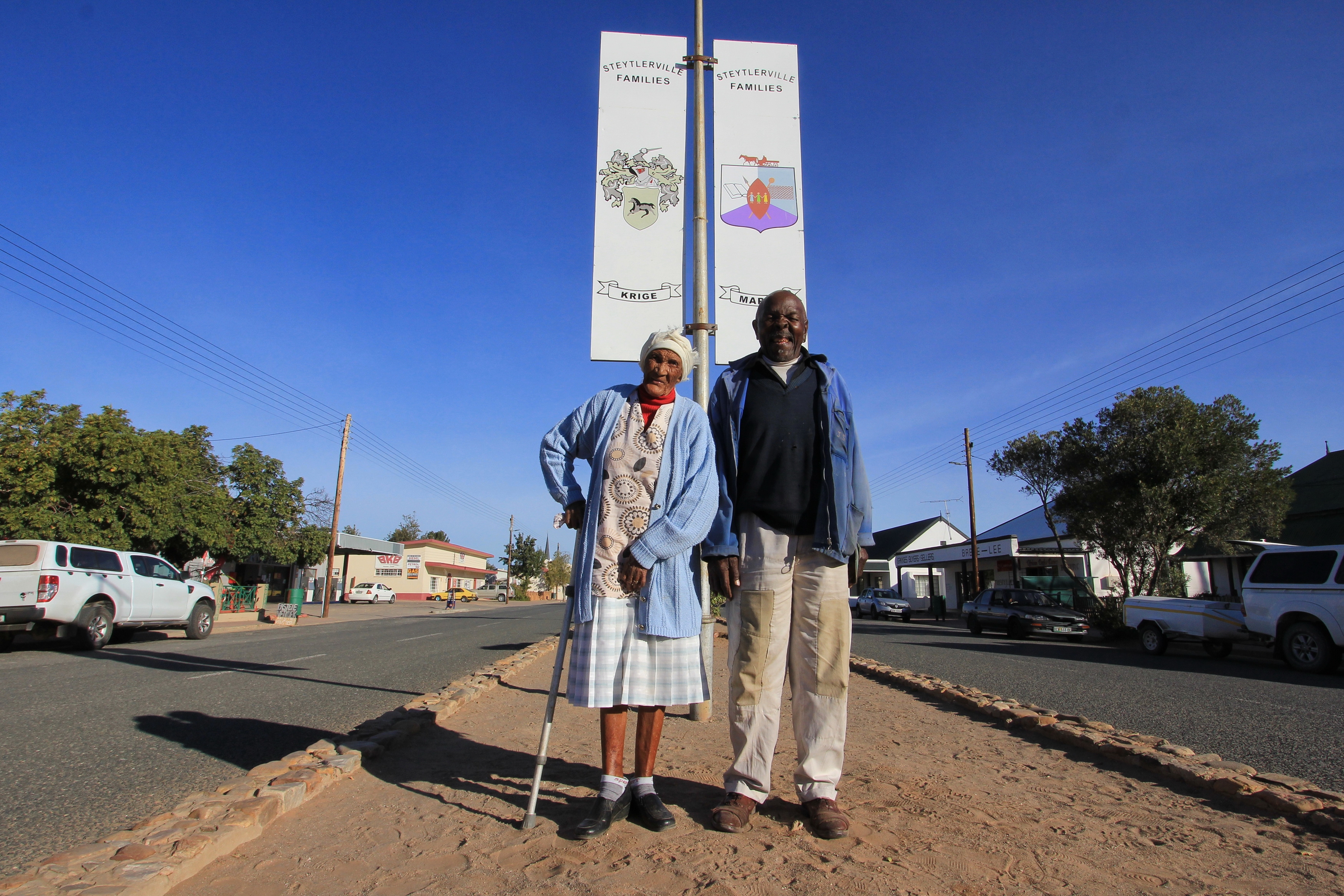
Freek and Nella Mapoe, photographed here in 2017. Image: Chris Marais
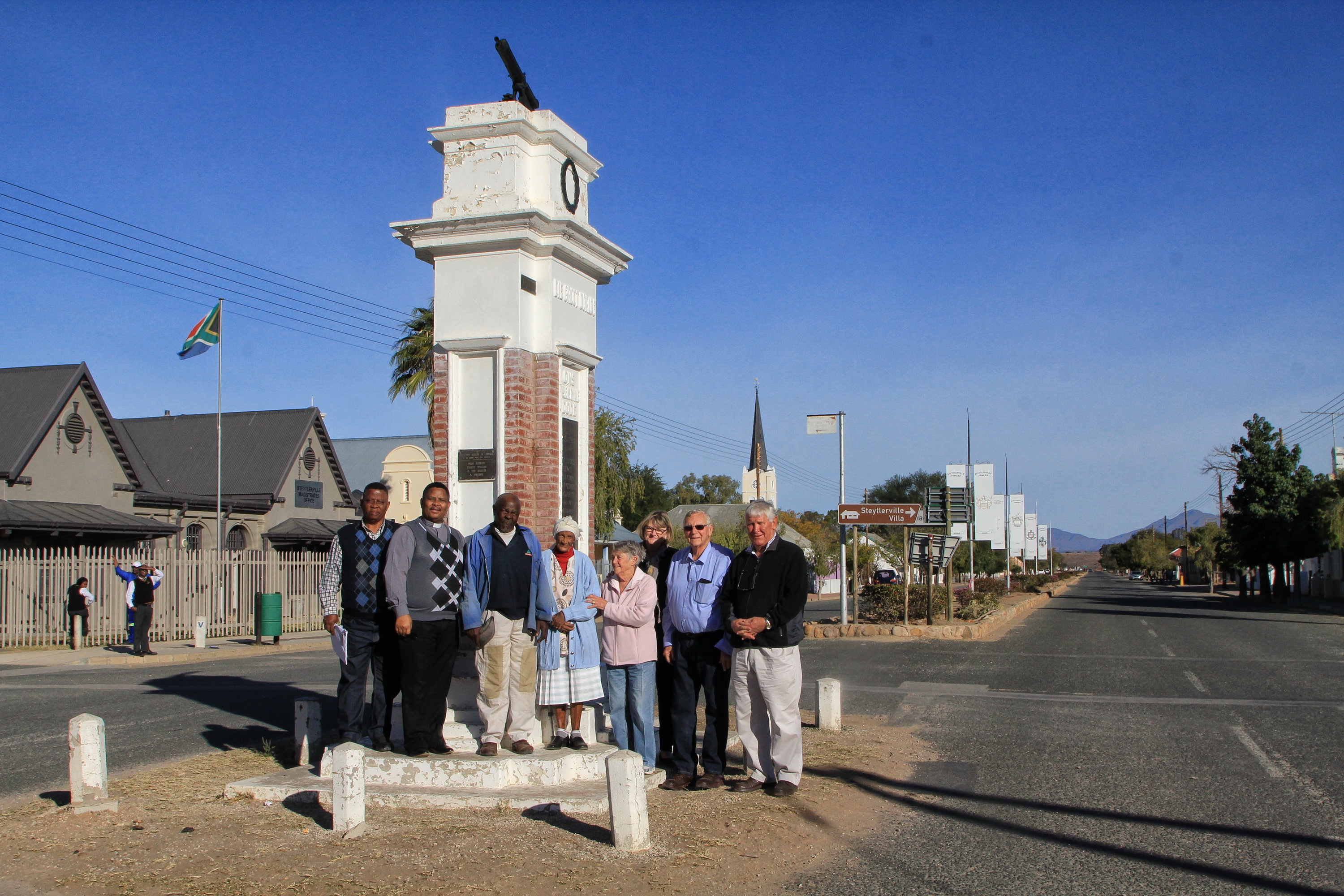
The Matabatas, Mapoes, Kirkman-Middletons, Linda Henderson and Danie Bezuidenhout gathering under the Steytlerville War Memorial. Image: Chris Marais
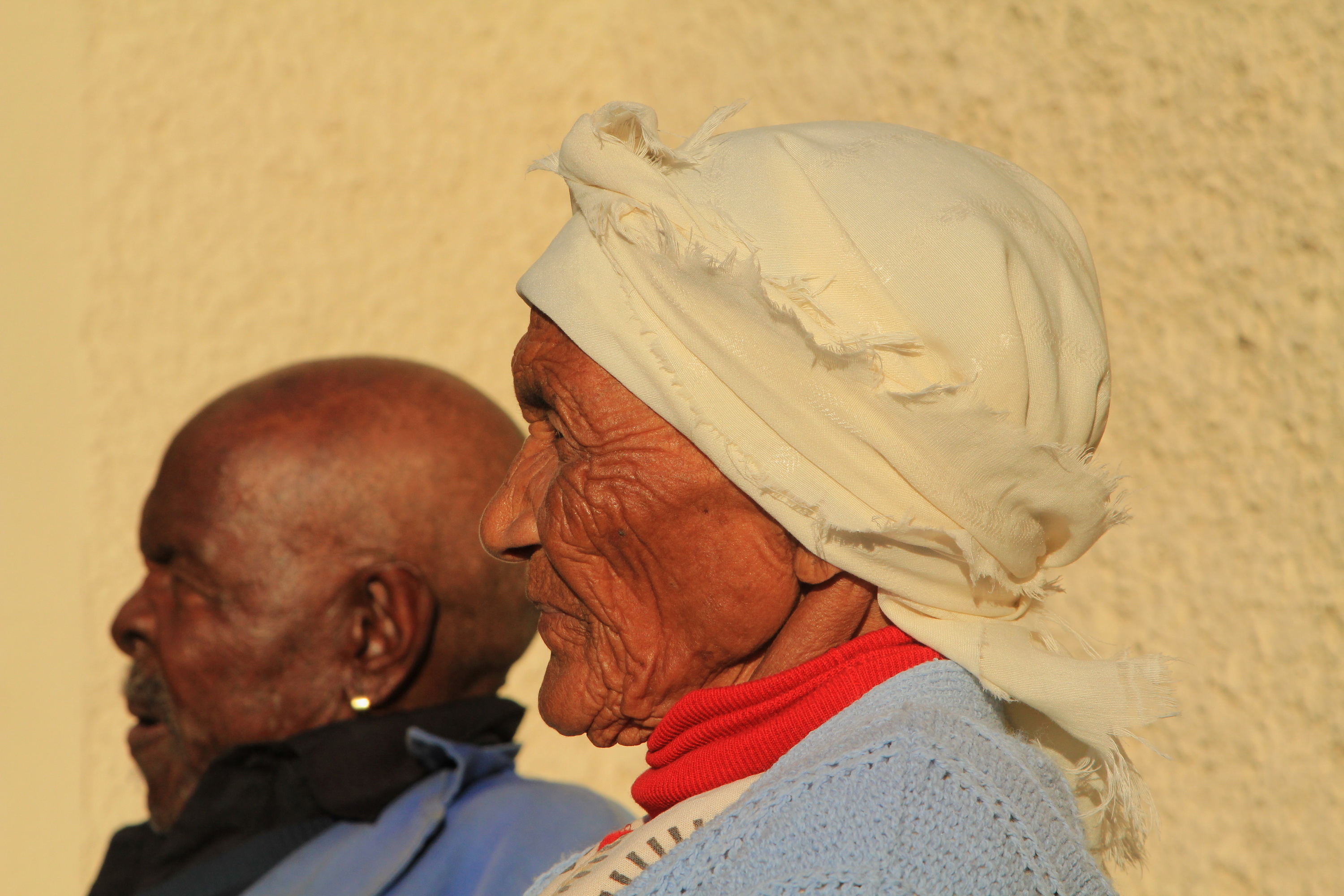
Nella Mapoe grew up in the Royal Hotel, and her husband Freek was a legendary stockman. Image: Chris Marais
The Mapoes
Our final encounter of the day was with Freek Mapoe (91) and his wife Nella (89), both charming and sharp as pins. There’s nothing you can teach Freek (whose nickname is Bulman) Mapoe about working on a Karoo farm.
A locally respected stockman, wire-spanner and shearer, Freek still has an appetite for work and gets a huge cake from Linda Henderson each year on his birthday. It’s not something he takes lightly.
The doughty Nella grew up on the grounds of the nearby Royal Hotel, because that’s where her father Hendrik Damans worked. Freek married Nella in 1951, after forward-paying her lobola (dowry) for many years.
The afternoon rolled on. We listened to these family memories with great interest and then it was time for the group photograph out at the War Memorial in the street.
As we were trooping out, with the photo-shy Linda Henderson (“the story isn’t about me, it’s about them”) trying her best to stay in the background, I picked up a buzz in the little crowd.
They were chatting together as long-lost friends, tying up old connections, throwing in memories here and there, as if each family had only one degree of separation from the next. As if, suddenly, issues of colour, creed or class had fallen away and all remained was the magic of being South Africans together. DM/ML
For an insider’s view on life in the Karoo, get the Three-Book Special of Karoo Roads I, Karoo Roads II and Karoo Roads III (illustrated in black and white) by Julienne du Toit and Chris Marais for only R800, including courier costs in South Africa. For more details, contact Julie at [email protected]




Comments - Please login in order to comment.